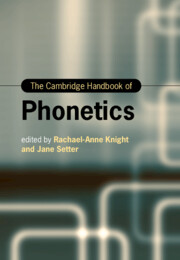Book contents
- The Cambridge Handbook of Phonetics
- Cambridge Handbooks in Language and Linguistics
- The Cambridge Handbook of Phonetics
- Copyright page
- Contents
- Figures
- Tables
- Contributors
- Introduction
- Section I Segmental Production
- 1 Physiological Foundations
- 2 Vowels
- 3 Consonants
- 4 Coarticulation
- 5 Processes in Connected Speech
- Section II Prosodic Production
- Section III Measuring Speech
- Section IV Audition and Perception
- Section V Applications of Phonetics
- Index
- References
4 - Coarticulation
from Section I - Segmental Production
Published online by Cambridge University Press: 11 November 2021
- The Cambridge Handbook of Phonetics
- Cambridge Handbooks in Language and Linguistics
- The Cambridge Handbook of Phonetics
- Copyright page
- Contents
- Figures
- Tables
- Contributors
- Introduction
- Section I Segmental Production
- 1 Physiological Foundations
- 2 Vowels
- 3 Consonants
- 4 Coarticulation
- 5 Processes in Connected Speech
- Section II Prosodic Production
- Section III Measuring Speech
- Section IV Audition and Perception
- Section V Applications of Phonetics
- Index
- References
Summary
When speech sounds are produced, articulatory movements for one sound overlap with those of the surrounding sounds, generating articulatory and acoustic signals that at any point in time are informative about two or more sounds, not just one. This process of intermingling of information about several speech sounds in the articulatory and acoustic signals is called coarticulation. This chapter synthesises theories and experimental findings of the last century on the nature of coarticulation, and shows how our modern understanding of this complex process is deeply rooted in theories that have evolved over decades due to novel experimental findings as well as critique from competing theories. After discussion of our current understanding of coarticulation, some suggestions for initiating students into the surprising effects of coarticulation are introduced.
Keywords
- Type
- Chapter
- Information
- The Cambridge Handbook of Phonetics , pp. 106 - 132Publisher: Cambridge University PressPrint publication year: 2021
References
4.6 References
- 1
- Cited by

